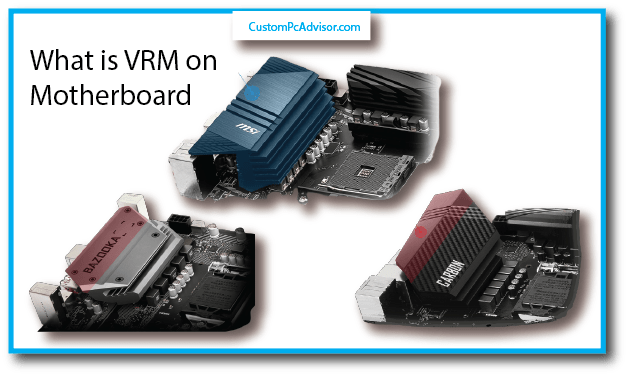Guys let’s jump on a journey into the world of VRMs. We will explain to you everything you need to know Think of them as the trusty Factors to your motherboard’s superhero the
CPU. These little parts might not mentioned too much, but they play a critical role in keeping your computer happy and functioning.
We’ll break it all down using simple words and a sprinkle of humor.
What is VRM Motherboard?
now let’s understand in short sentences What is VRM on a Motherboard
What’s VRM and Why Should You Care?
Imagine VRM as the guardian angel of your PC components. It stands for Voltage Regulator Module, and its job is to make sure your CPU, memory,
and pals get just the right amount of power. Think of it as the bouncer at the club letting in the right vibes and keeping out the troublemakers.
How VRM Works
So, your power supply dishes out 12V power to the motherboard. VRM steps in like a wizard, converting this power to the Goldilocks-approved levels your components crave.
It uses cool stuff like MOSFETs (fancy switches), chokes (noise filters), and capacitors (power stabilizers). It’s like a mini power spa for your PC.
Why VRM is Your PC’s Important Part
VRM is crucial because it’s the peacekeeper. Too much voltage can heat your components, and too little can turn your system into a diva throwing a tantrum.
Plus, if you’re into overclocking (making your components party harder), you need a VRM that can handle the heat.
How to Boost Your VRM’s Performance (Overclocking 101)
Planning to make your PC flex its muscles? If you’re overclocking, your VRM needs a pep talk too. Tweak the voltage settings in your BIOS or UEFI just don’t go overboard.
Too much voltage and your VRM might throw an “I need a break” tantrum.
Red Flags – Is Your VRM on the Blink?
If your system’s acting like a moody teenager – unstable, crashing, or just not performing – your VRM might be the culprit.
Check for signs of overheating, like components looking roasted or changing colors. If your VRM is on the fritz, act fast before it ruins the whole party.
Summing it Up – VRM is Your Computer’s Helper
To wrap it up, VRM is like the backstage crew of your PC concert. It ensures everything runs smoothly, from the spotlight on your CPU to the beats in your memory.
So, when choosing a motherboard, give a nod to the quality of its VRM. Your PC will thank you with smoother performances and fewer meltdowns.
Different Types of VRM
VRMs come in a variety of flavors, and I’m here to make it as simple as a Sunday morning for you.
Types of VRMs
now let’s understand the different types of VRM Available and what they Do
Single-stage VRMs:

The budget-friendly option; is simple and gets the job done but can be a bit noisy and may struggle with power-hungry components.
Multiphase VRMs:

A bit more sophisticated, using multiple MOSFETs and inductors. It’s like having a team of superheroes to handle power demands, reducing noise and boosting efficiency.
Digital VRMs:
The budget-friendly option; is simple and gets the job done but can be a bit noisy and may struggle with power-hungry components.
MOSFETs:
Now, let’s talk about the MOSFETs, the magic behind VRMs.
N channel MOSFETs:
Like the worker bees of VRMs common, cost-effective, and easy to handle.
P channel MOSFETs:
A bit rarer but packs a punch in performance and efficiency. A VIP MOSFET, if you will.
inductors:
inductors are the silent guardians against power supply noise. Here, we have:
Open inductors:
Your everyday heroes are affordable and easy to find.
Closed inductors:
The elite squad offers top-notch performance and efficiency but at a slightly higher price.
Capacitors:
Capacitors store energy and keep things smooth. Two types to choose from:
Electrolytic capacitors:
Your reliable buddies are cheap and high on capacity.
Solid state capacitors:
The A-listers are pricier, but top-tier in performance and reliability.
Finding Your VRM Soulmate
So, when choosing your VRM, think about your components’ power needs, the phase count, MOSFET preferences, choke types, and capacitor styles.
It’s like matchmaking for your motherboard finding the perfect fit for a long and happy relationship.
In a nutshell, whether you’re into the budget-friendly single-stage vibes, the multitasking multiphase flair, or the high-end digital sophistication, there’s a VRM out there for everyone. Happy building! 🚀
VRM Motherboard Components
Let’s dive into the fascinating world of VRM components the important Part of your motherboard. Picture this: your CPU is the rockstar,
and these components are the backstage crew making sure the show goes on smoothly.
1. MOSFETs
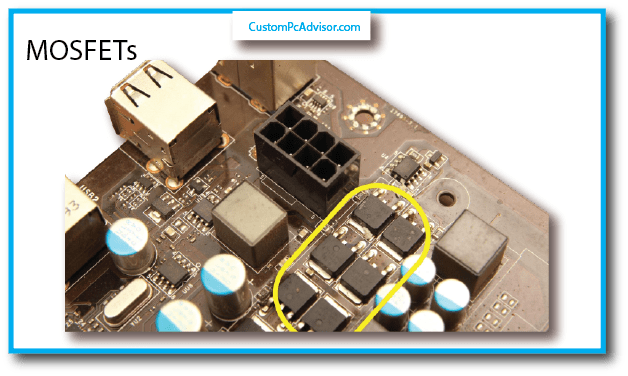
Imagine MOSFETs as tiny wizards that switch power on and off, ensuring your CPU gets just the right voltage. They’re like the traffic controllers of your motherboard, managing the
flow efficiently. When picking them, think of current and voltage ratings you want them to handle the CPU’s power demands like a champ.
2. Inductors
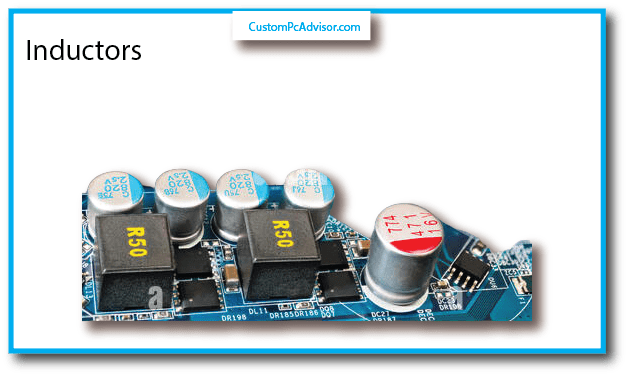
Meet the inductors, or chokes, if you will. They’re the energy stash, releasing power to your CPU when needed.
But they’re not just storage; they also filter out noise like superheroes with noise-canceling powers. Look for high inductance and low DC resistance for top-notch performance.
3. Capacitors

Capacitors are like energy buffers, storing power and delivering it to your CPU when it’s time to shine. Think of them as the cool, calm, and collected members of the VRM team.
High capacitance, proper voltage ratings, and low ESR are the qualities you’re looking for in these energy rockstars.
4. VRM Controller
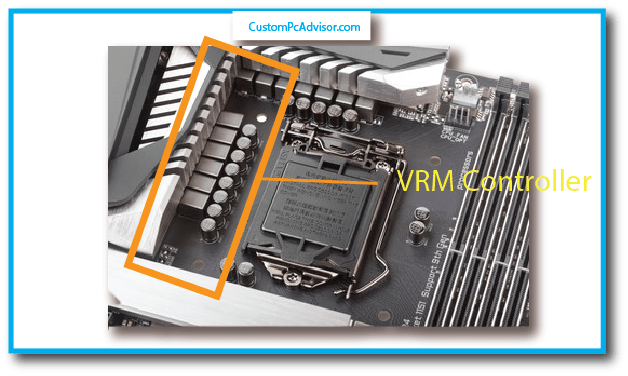
Meet the VRM controller the boss of MOSFETs. It gives signals, watches voltage, and adjusts things. When choosing one, look at the phase count for power,
voltage regulation for stability, and current capability for good performance.
How Does VRM Improve CPU Performance?

Let’s dive into the fascinating world of VRM and how it’s your CPU’s best buddy for boosting performance.
Imagine VRM as the wise wizard ensuring your CPU gets the perfect potion of power. Let’s break down the magic:
| Benefits of a Rockstar VRM | How it Works its Magic |
|---|---|
| Stable Voltage Supply | VRM ensures your CPU gets a steady stream of power, like a barista making your coffee just right. No burnt CPUs here! |
| Voltage Drop Prevention | Say goodbye to performance hiccups! VRM keeps the voltage flowing strong, even when your CPU is hitting the gym with heavy tasks. |
| Cooler Temperatures | It’s like having a personal fan for your CPU. VRM reduces the heat, so your CPU doesn’t break a sweat (literally). |
| Extended CPU Lifespan | Think of VRM as the superhero shield protecting your CPU from the villains of voltage fluctuations and overheating. Lifesaver! |
Now, let’s sprinkle some humor on this tech talk. Imagine your CPU as a race car, and the VRM as the pit crew making sure it gets the best fuel,
stays cool, and finishes the race without a hitch. Who knew motherboards could be so cool, right?
Choosing a VRM Motherboard
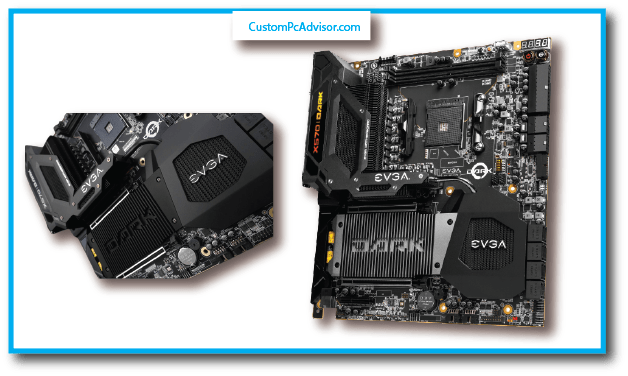
| VRM Need | Recommended Phase Count |
|---|---|
| Normal Usage | 4-6 Phases |
| Mild Overclock | 6-8 Phases |
| High End Beast | 8+ Phases |
1. MOSFETs: The Power Bouncers
Meet the MOSFETs – the bouncers of your computer club. High-quality ones are like those cool bouncers who let only the VIP volts in.
Look for a motherboard with these MOSFET rockstars for a tech night out that won’t disappoint.
2. Cooling Crew: Keepin’ it Cool, Literally!
Things can get hot in Motherboard City, especially for our MOSFET buddies. That’s where heatsinks and fans come in – the AC units of the motherboard world. Keepin’ it cool,
keeping it snappy – it’s like having a breeze at a beach party but for your tech gear.
Now, let’s put some motherboard personalities into the mix:
Budget-friendly: MSI B560M Mortar
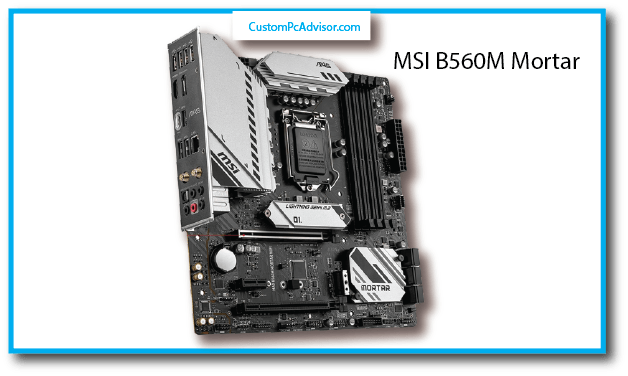
Affordable coolness for your everyday tech adventures.
Mid-Range: ASUS ROG Strix B660-F Gaming
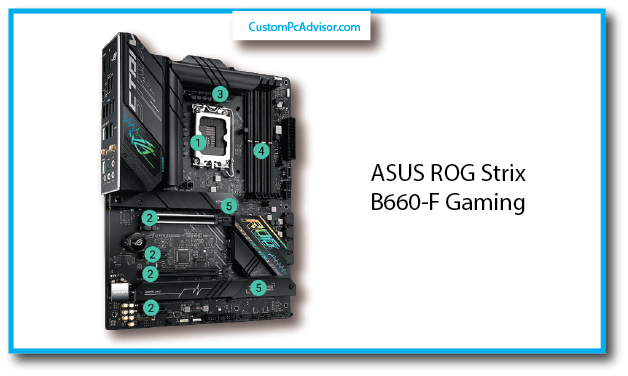
For the overclocking hero who doesn’t want to mortgage their house for a motherboard.
High End power: ASUS ROG Maximus Z690 Extreme Glacial

The name is epic, and so is the power. Unleash your CPU beast with this bad boy.
And there you have it, tech amigo! Picking a VRM motherboard is like choosing a sidekick for your digital crusade. Add some phases, get cozy with those
MOSFET bouncers, and make sure your motherboard stays cooler than a snow cone. Your computer will thank you with performances smoother than a salsa dance.
Common VRM Issues
now let’s cover all the Common VRM issues that you can face! if you are facing any problems with VRM then consider all these factors that we have mentioned down below
1. Overheating:
- Problem: VRM getting too hot.
- Easy Fix:
- Clean dust off those fan thingies.
- Check if the fans are spinning right.
- Make friends with more fans or move computer stuff around.
- Give it a spa day with a new thermal paste.
2. Voltage Drop:
- Problem: Power playing hide and seek.
- Easy Fix:
- Upgrade to a better VRM buddy.
- Make sure the power supply is giving enough juice.
- Don’t let the CPU lift too many weights.
- Bring in a voltage superhero.
3. Instability:
- Problem: The computer acting all jittery.
- Easy Fix:
- Update your computer’s DJ, aka BIOS.
- Give a little more power love.
- Adjust some dance settings for confidence.
- Cool it with the fancy speed stuff.
4. Failure:
- Problem: Computer not turning on? Acting crazy?
- Reality Check:
- Too much stress? Time for a new VRM buddy.
How to Be the Computer’s Bestie
- Stay Cool:
- Keep that VRM cool like an ice cream cone.
- Get a Good Buddy:
- Choose a VRM friend wisely.
- Don’t Go Too Fast:
- The computer doesn’t like too much speed.
- Keep Date Nights:
- Regularly chat with BIOS – it’s like the computer’s diary.
What exactly does a VRM on a motherboard do?
A Voltage Regulator Module (VRM) is a crucial component on your motherboard. Think of it as a mini power station. It takes the power from your main supply, which is usually around
12 volts, and converts it into a lower voltage, typically around 1 volt. This lower voltage is what your Central Processing Unit (CPU) and other components need to function correctly.
Without the VRM, these components wouldn’t get the right amount of power they need to operate.
Is a good VRM important for my computer performance?
Absolutely! A good VRM is like a reliable heart pumping blood to your body. It ensures a steady and clean flow of power to your CPU. This can lead to smoother performance,
especially when your computer is working hard, like when you’re playing a game or running a heavy software. So, a good VRM can make a significant difference in your computer’s performance.
How can I tell if a motherboard has a good VRM?
Identifying a good VRM isn’t always straightforward. One thing you can look for is large heatsinks around the CPU socket on the motherboard.
These often indicate robust VRMs. Also, reviews and online tech communities can be helpful resources for comparing VRM quality on different motherboards. Remember,
a good VRM will contribute to the overall performance and longevity of your computer.
Do VRMs affect how much I can overclock my CPU?
Yes, they do. Overclocking is like asking your CPU to run a marathon. A good VRM is essential for stable overclocking because it provides the extra power needed without
causing overheating or crashing. So, if you plan to push your CPU beyond its stock settings, a strong VRM is crucial.
Can a bad VRM damage my CPU?
In extreme cases, a failing VRM could deliver unstable voltage, which could potentially damage your CPU. It’s like feeding your body with unhealthy food; it might not cause
immediate harm, but over time, it could lead to serious health issues. However, modern motherboards have safeguards to prevent this from happening in most situations.
Are VRMs more important for powerful CPUs or graphics cards?
VRMs are primarily important for the CPU. It’s like the brain of your computer, and the VRM ensures it gets the right amount of power. Graphics cards, on the other hand, have their
own built-in voltage regulation systems. So, while VRMs are important for both, they play a more critical role for the CPU.
How can I tell if my VRM is overheating?
Some motherboards have built-in temperature sensors for the VRM. You can check your BIOS or software provided by your motherboard manufacturer to see if this information is
available. If your computer is shutting down unexpectedly or experiencing performance issues, it could be a sign of VRM overheating. It’s like your computer telling you it’s feeling unwell.
Does the size of the heatsink on the VRM matter?
Generally, a larger heatsink indicates a more robust VRM that can handle more heat. This is especially important for powerful CPUs or overclocking.
It’s like having a bigger fan or air conditioner to cool down a room; the larger it is, the more heat it can handle.
Is it possible to upgrade the VRM on a motherboard?
No, VRMs are integrated into the motherboard and cannot be realistically upgraded. It’s like trying to change the engine of a car; it’s not a simple task and usually not feasible.
What are some features to look for in a VRM for gaming?
For gaming, you’d want a motherboard with VRMs that use high-quality components and have efficient cooling solutions. Features like digital VRMs and doublers
(which help deliver more power) can also be beneficial. It’s like choosing a car for racing; you’d want one with a powerful engine, a good cooling system, and high-quality parts.
Do VRMs affect how quiet my computer is?
Yes, they do, but indirectly. VRMs can generate heat, and the fans used to cool them can contribute to the overall system noise. It’s like a busy kitchen; the more cooking
(or power conversion) that’s happening, the more heat is produced, and the louder the fans (or exhaust) need to work.
A well-designed VRM with efficient cooling should be relatively quiet, just like a well-ventilated kitchen.
Are there any online tools to compare VRMs on different motherboards?
Unfortunately, there aren’t many universal tools specifically for VRM comparison. It’s like trying to find a tool that compares the engines of all car models. However, tech review
websites often analyze and compare VRM quality among different motherboards. These can be a great resource when you’re shopping for a new motherboard.
Should I be worried about VRMs if I’m building a basic PC?
For basic tasks like browsing the web or using productivity software, VRM quality isn’t as critical. It’s like driving a car in the city; you don’t need a high-performance engine.
However, if you plan on gaming, video editing, or other demanding tasks, a good VRM becomes more important. It’s like needing a more powerful engine for racing or towing.
How much does the quality of the VRM affect the price of a motherboard?
The quality of the VRM can indeed affect the price of a motherboard. Higher quality VRMs often use better components and require more robust cooling solutions,
which can contribute to a motherboard’s price. It’s like choosing a car; a model with a more powerful and efficient engine will generally cost more.
Are there any websites that explain how VRMs work in detail?
Yes, many tech websites and hardware manufacturers offer detailed explanations of VRMs and their function on motherboards. It’s like finding a good cookbook that explains the
science behind cooking. You can find these resources through a web search.
What are the different components that make up a VRM?
The main components of a VRM include MOSFETs (transistors that regulate voltage), chokes (coils that smooth out power delivery), and capacitors
(which store electrical energy). It’s like a kitchen where the MOSFETs are the chefs, the chokes are the utensils, and the capacitors are the ingredients.
Can a faulty VRM cause random crashes or blue screens?
Yes, a failing VRM can lead to unstable power delivery, which can manifest as random crashes, blue screens, or unexpected shutdowns.
It’s like a car with a faulty engine; it can stall or stop running at any time.
How long should a VRM typically last before needing replacement?
VRMs are generally very durable and can last for the lifespan of the motherboard itself, often several years.
It’s like a well-built house; with proper care and maintenance, it can last for a very long time.
Are there any tests you can run to diagnose VRM health?
There aren’t specific tests designed solely for VRMs, but you can use some stress testing software as a workaround. This software puts a heavy load on your CPU, similar to a runner
on a treadmill, which can help identify potential VRM issues like overheating or instability. However, this should be done with caution, just like you wouldn’t want to overwork the
runner on the treadmill. Stress testing can push your hardware to its limits, so it’s important to monitor the system carefully during the test to avoid any damage.
Conclusion
In conclusion, your computer’s unsung hero, the VRM, works behind the scenes to ensure optimal power delivery. If you’ve noticed some glitches whether it’s overheating or erratic behavior don’t fret! Simply
treat your VRM to a clean up for a cool and smooth operation. Keep those fans spinning like loyal cheerleaders, and imagine your computer as a cozy room with exclusive airflow for ultimate happiness.
Sometimes, upgrading your VRM’s sidekick gear, like quality thermal paste, can be a game changer. Consider it a superhero power up. As a bonus, throw in a software spa day by updating the BIOS and, if
things get too wild, ease up on overclocking for a glitch free experience. Your computer superhero is ready to reward you with smooth, trouble free adventures! 🚀✨
FAQs
What is VRM?
VRM means voltage regulator module. It manages power for your computer parts like the CPU.
Why is VRM important?
VRM is crucial because it gives the right power to your CPU and parts. Wrong power can harm them.
Different types of VRMs?
Two types: single phase (simple, cheaper) and multi-phase (complex, better).
How to know if VRM is good?
Check phases (more is usually better) and quality parts like MOSFETs.
Do I need multi phase VRM?
If tight on money or have no overclocking, a single phase is okay. For more money and overclocking, go multi phase.
Signs of VRM problems?
Crashes, lower performance, overheating, burning smell from motherboard.
How to troubleshoot VRM issues?
Check the temperature with HWMonitor. Verify CPU voltage with CPU Z. Adjust settings in BIOS/UEFI if needed. Contact motherboard support if problems persist.
Can I replace VRM?
Yes, but it’s complex. Best done by experienced users.
Preventing VRM problems?
Ensure good case airflow. Avoid heavy overclocking with single phase VRM. Choose a motherboard with a multi phase VRM for high end systems.
Choosing a motherboard with a good VRM?
Read reviews, and compare specifications. Look for more phases and quality components.

